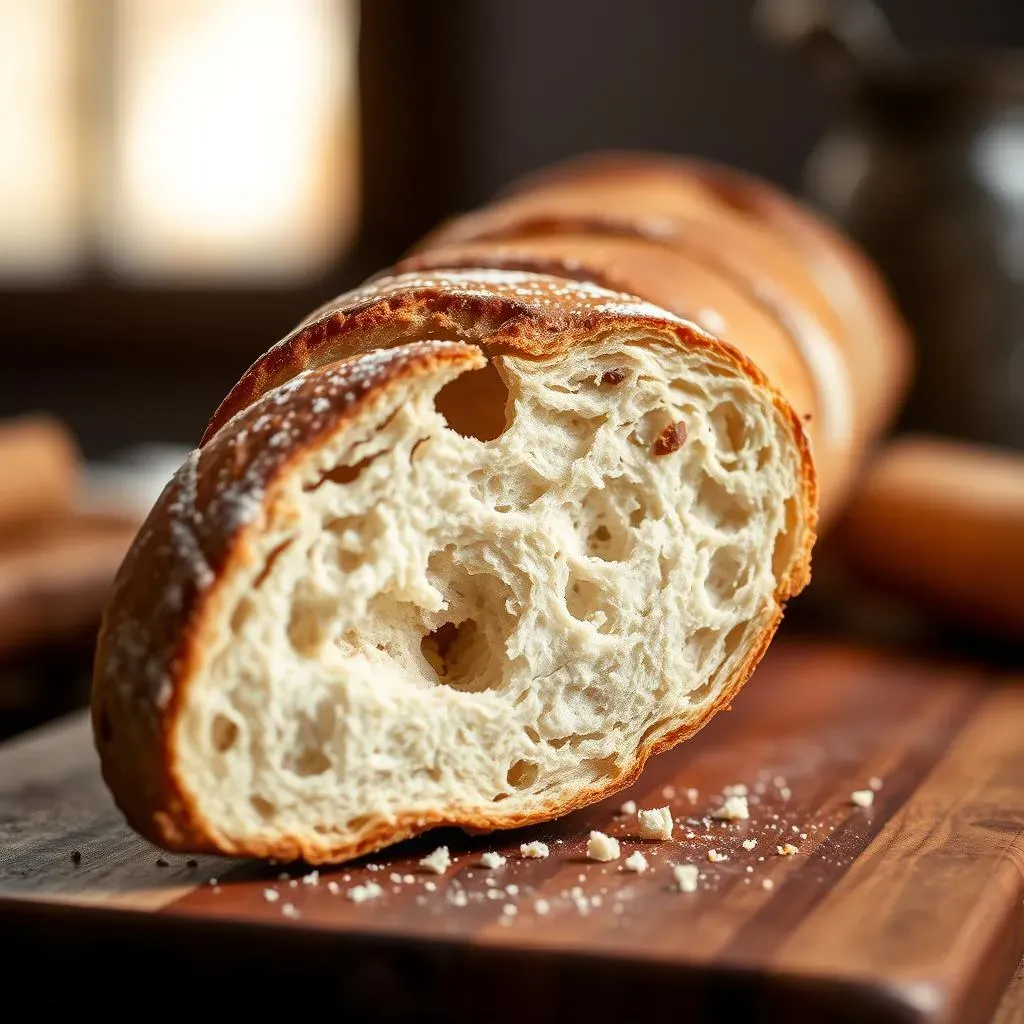Table of Contents
Ah, the French baguette—a culinary masterpiece, a symbol of Parisian chic, and... a surprisingly perishable item. That crispy crust, that airy crumb, that irresistible aroma—all too quickly, it can transform into a sadly stale snack. But fear not, baguette lovers! This article is your ultimate guide to conquering the challenge of "how to keep french baguette bread fresh." We'll unravel the science behind why baguettes go stale, exploring the crucial role of moisture and starch. Then, we'll arm you with practical, easy-to-follow storage techniques—from simple tricks to more advanced methods—to keep your baguette tasting its best for longer. But what about that slightly hardened baguette lurking at the back of the bread bin? Don't despair! We'll show you how to revive even the stalest baguette with a few simple steps, turning a potential waste into a delicious treat. Finally, we'll explore creative ways to use leftover baguette, transforming day-old bread into mouth-watering dishes. Get ready to elevate your baguette game and enjoy every delicious crumb!
The Science of Stale Bread: Why Baguettes Go Hard

The Science of Stale Bread: Why Baguettes Go Hard
The Role of Moisture
Imagine a baguette as a tiny sponge. Freshly baked, it’s full of moisture, giving it that wonderful soft crumb and crisp crust. As time passes, that moisture starts to escape. This drying process is the first step towards staleness. The starch molecules in the bread begin to rearrange themselves, creating a harder, less appealing texture. It's a bit like a sandcastle losing its water—it starts to crumble and loses its shape.
This moisture loss is especially pronounced in baguettes because of their low fat content and high surface area. Fat helps retain moisture, so leaner breads like baguettes dry out faster than, say, a richer loaf of sourdough. Think of it like this: a juicy steak retains moisture better than a piece of grilled chicken breast. To understand the difference between baguettes and other breads, check out our article on baguette vs french bread.
Bread Type | Fat Content | Moisture Retention | Staling Rate |
|---|---|---|---|
Baguette | Low | Low | Fast |
Sourdough | Medium | Medium | Moderate |
Brioche | High | High | Slow |
Starch Retrogradation: The Molecular Mystery
Now, let's talk about starch. The starch molecules in bread are like tiny, intertwined strands. When the bread is fresh, these strands are nicely organized. But as the bread loses moisture, the starch molecules start to re-arrange themselves—this is called retrogradation. It's like those strands getting tangled and clumped together, making the bread harder and chewier. This process is irreversible, which is why completely stale bread doesn't magically become soft again.
The speed of retrogradation depends on several factors, including temperature. Colder temperatures actually speed up this process, which is why putting your baguette in the fridge isn't the best idea. For more detailed information on baking your own bread, check out our guide on how to make french baguette bread.
- Moisture loss initiates starch retrogradation.
- Retrogradation leads to a harder, less palatable texture.
- Low temperatures accelerate retrogradation.
Preventing Stale Bread: A Proactive Approach
So, how do we combat these moisture-related issues and starch shenanigans? The key is to slow down both moisture loss and starch retrogradation. We'll explore some practical methods in the next section, but understanding the science behind stale bread is the first step towards baguette bliss. Proper storage is paramount, and we'll cover the best techniques, from simple wraps to more sophisticated methods.
Remember, a fresh baguette is a delicate balance of moisture and starch structure. By understanding the factors that contribute to staleness, you can take steps to preserve that perfect texture and flavor. For a delicious way to use up any leftover baguette, try our recipe for French toast with baguette bread.
Smart Storage Solutions: Keeping Your Baguette at its Peak

Smart Storage Solutions: Keeping Your Baguette at its Peak
The Paper Bag Method: Simple and Effective
Let's start with the simplest solution: the humble paper bag. This isn't your average plastic grocery bag; we're talking about a breathable paper bag, the kind you might find at a bakery. The breathability is key! It allows the baguette to "breathe," preventing excessive moisture buildup that can lead to sogginess while still offering some protection from the drying air. Think of it as a Goldilocks approach—just the right amount of protection.
Place your baguette in the paper bag, and store it at room temperature, away from direct sunlight or heat. This method works best for baguettes you plan to eat within a day or two. For more on creating your own baguettes from scratch, take a look at our guide on French baguette recipes.
- Use a breathable paper bag.
- Store at room temperature, away from heat and direct sunlight.
- Best for consumption within 1-2 days.
Advanced Techniques: For Longer Freshness
For longer-term storage (think a few days), we need to up our game. Consider using an airtight container. This isn't your average Tupperware; we're talking about a container designed for bread storage, often with a slightly porous lid that allows for some air circulation. This helps prevent the baguette from drying out too much while still keeping it protected from the elements. You can also wrap your baguette tightly in plastic wrap before placing it in the container.
Another option is to freeze your baguette. Yes, freezing! Wait until your baguette is completely cool, then wrap it tightly in plastic wrap or aluminum foil, and place it in a freezer bag. Remove as much air as possible before sealing. Frozen baguettes can last for several months. When you're ready to eat it, thaw it slowly at room temperature, then pop it in a preheated oven for a few minutes to crisp up the crust. For more ideas on using your baguette, check out our post on baguette French toast bake.
Storage Method | Freshness Duration | Notes |
|---|---|---|
Paper Bag | 1-2 days | Room temperature, away from heat and sunlight |
Airtight Container | 3-4 days | Wrap tightly in plastic wrap first |
Freezing | Several months | Wrap tightly, remove air from freezer bag |
The Refrigerator: Friend or Foe?
The refrigerator is a tricky one. While it might seem logical to store your baguette in the fridge to slow down spoilage, the cold temperatures actually speed up starch retrogradation, leading to a faster-than-expected hardening. It’s a bit counterintuitive, but it's true! So, while refrigeration might seem like a safe bet, it's not ideal for keeping your baguette at its peak.
Instead of refrigeration, focus on the methods we've discussed: room temperature storage in a paper bag for short-term freshness, airtight container storage for a few days, or freezing for longer-term storage. If you're looking for more information about the differences between baguettes and other types of bread, you might find our comparison of baguettes vs. French bread helpful.
Reviving a Stale Baguette: Quick Fixes and Tasty Makeovers

Reviving a Stale Baguette: Quick Fixes and Tasty Makeovers
The Quick Fix: Oven Revival
Don't toss that stale baguette just yet! A quick trip to the oven can often work wonders. Lightly sprinkle your baguette with water—just a few sprays will do—and pop it into a preheated oven (around 350°F or 175°C) for 5-7 minutes. The heat helps to re-hydrate the bread, softening the crumb and crisping up the crust. It's like giving your baguette a mini spa treatment!
This method is great for baguettes that are only slightly stale. For those that are a bit more hardened, you might need to add a few more minutes in the oven. Keep a close eye on it to prevent burning! For those who love experimenting with different bread types, you might be interested in our article on baguettes vs. French bread.
- Lightly mist with water.
- Bake at 350°F (175°C) for 5-7 minutes.
- Monitor closely to avoid burning.
From Stale to Sublime: Creative Transformations
Even if your baguette is beyond simple oven revival, don't despair! Stale baguettes are incredibly versatile. They make fantastic croutons for soups and salads. Simply cube the bread, toss it with olive oil and herbs, and bake until golden brown and crispy. You can also grind stale baguette into breadcrumbs, perfect for coating chicken or adding to meatballs. They even make a surprisingly delicious base for bread pudding!
Think outside the box! Stale baguette pieces can thicken soups and stews, adding a lovely texture and subtle flavor. Or, take a look at our recipe for French toast—it's a delicious way to use up stale bread. There are countless possibilities!
Stale Baguette Use | Method | Result |
|---|---|---|
Croutons | Cube, toss with oil and herbs, bake | Crispy and flavorful topping |
Breadcrumbs | Grind in food processor | Versatile coating or addition to recipes |
Bread Pudding | Soak in custard, bake | Sweet and comforting dessert |
Beyond the Bite: Creative Uses for DayOld Baguettes

Beyond the Bite: Creative Uses for DayOld Baguettes
Beyond the Bite: Creative Uses for Day-Old Baguettes
Let's face it: sometimes, even with the best storage techniques, a baguette might end up a little past its prime. But before you toss it, remember this: stale baguettes are culinary goldmines waiting to be rediscovered! Think beyond simple sandwiches and explore a world of flavor and texture.
Croutons are a classic, and for good reason. Simply cube your stale baguette, toss it with olive oil, herbs (rosemary and thyme are fantastic!), and a pinch of salt and pepper. Bake until golden brown and crispy—perfect for salads, soups, or even as a crunchy topping for roasted vegetables. For an extra flavor kick, try adding some garlic powder or parmesan cheese. If you're looking for more ways to use your leftover bread, check out our garlic bread recipes.
- Croutons: Cube, toss with herbs and oil, bake until crispy.
- Breadcrumbs: Pulse in a food processor for coating or thickening sauces.
- Soup Thickener: Add cubed stale baguette to simmering soups for body and flavor.
Don't underestimate the power of breadcrumbs! A quick trip to the food processor transforms stale baguette into perfectly textured breadcrumbs. Use them to coat chicken, fish, or meatballs, adding a delightful crunch. They're also fantastic for thickening sauces or adding texture to casseroles and stuffings. For a detailed guide on bread making, check out our how-to-make-french-baguette-bread article.
And let's not forget the humble bread pudding! This classic comfort food is a perfect way to use up stale bread. Soak cubed baguette in a creamy custard mixture, studded with raisins, chocolate chips, or other delicious additions. Bake until golden brown and set – a delightful dessert that's both economical and incredibly tasty. For a twist on the classic, check out our baguette french toast bake recipe.
Creative Use | Description | Flavor Pairing Suggestion |
|---|---|---|
Garlic Bread Croutons | Cubed, seasoned, and baked baguette pieces | Tomato soup, Caesar salad |
Herb-Crusted Chicken | Chicken coated in baguette breadcrumbs | Lemon, parsley, garlic |
Bread Pudding | Stale baguette soaked in custard | Cinnamon, nutmeg, vanilla |
